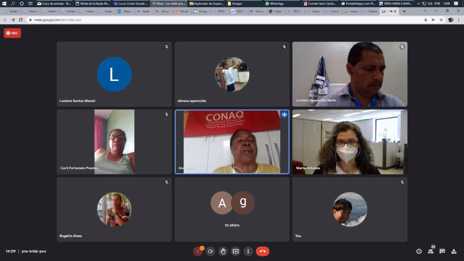UE-PR discusses Census with quilombola communities
March 08, 2022 15h41 | Last Updated: March 15, 2022 14h49

Last Monday, February 21, the central administration and the IBGE State Branch of Paraná (UE-PR) carried the Seminar on Census in Paraná´s Quilombola Communities, organized in partnership with CONAQ (National Confederation of Articulation of Black Quilombola Rural Communities). The aim of the meeting was to take information about the 2022 Census to quilombola leaders in the state, as well as to strengthen the partnership to carry out the first Population Census that will count the quilombolas - how many they are, where they are and how they live. Therefore, the 2022 Census will be the “First Quilombola Census.”
Besides representatives from all quilombola communities and regions in the state, the seminar was followed by partners like the Terra de Direitos NGO, the United Nations Population Fund (UNFPA) and the Census team in Paraná. Ana Maria Cruz, member of the CONAQ´s national coordination and a resident in the Invernada Paiol de Telha quilombo, in Reserva do Iguaçu (near Guarapuava, in the center-south of Paraná), opened the meeting reminding the history of the quilombola movement, which became stronger in the last 30 years. Antônio Mendes, of the CONAQ´s national coordination, reminded how difficult it was for the quilombolas to identify themselves as black, let alone as quilombolas.
Cruz and Mendes also reminded the work of the Clóvis Moura Workgroup, organized by the Paraná government between 2005 and 2010 to raise and identify quilombola communities and remnant quilombos in the state. Thanks to the effort of the workgroup, there are 38 quilombola communities certified in the state today. Mendes also mentioned how the quilombolas dream of leaving invisibility, know how many they are, where they are.
Since the 2000s, the quilombola movement works for the quilombola communities to be identified in the Population Census. The favorable decision occurred in 2016 and, ever since, the IBGE has worked in partnership with CONAQ to develop questions and specific methodologies to be applied in these communities.
The quilombolas in the Census
Marta Antunes, an analyst of the IBGE´s Traditional Communities and Peoples Project, explained that the communities are identified for the census as “quilombola enumeration areas.” No specific questions on quilombolas will be made outside these places. Therefore, it is important that all these communities are properly identified to the IBGE. The reason is that the DMC (data collection mobile device) will use the localization of the household to select the questionnaire to be answered, based on the maps that the IBGE developed (the Territorial Base). The development of the Territorial Base in terms of quilombola communities is based on the work of INCRA (National Institute for Colonization and Agrarian Reform), the institution in charge of the titulation of quilombola territories. INCRA uses the self-attribution criterion, in which the communities themselves define them as quilombolas.
Antunes also explained that all the households in quilombola enumeration areas will answer the complete Census questionnaire (called “sample questionnaire”). Therefore, enumerators should ask a little patience to the population and CONAQ will ask the support of local leaders to warn their communities about the importance of answering the Census. Before the data collection, the enumerators will introduce them to local leaders, who can help to identify non-mapped households and take information about the Census to residents. Leaders can determine whether local guides are needed, as well as appoint them. Therefore, the Community Guide can guarantee the security of enumerators and help to carry out the Census. Guides should be able to identify and negotiate local issues, including conflicts, special dates, physical access and respect to specific health barriers in the localities.
Flávio Roberto Schüler de Oliveira, technical coordinator of the 2022 Population Census in Paraná, introduced the planning actions in the UE-PR, focused on the quilombola subject. In the planning phase, the state team maps quilombola communities and territories in the state, supported by local organizations. This work depends a lot on field work and meetings with people in the communities, a moment in which it is also possible to disseminate the Census in these communities, raising awareness about the importance of this work. Lastly, the detailing of each community is being conducted, aiming at planning the approach and sizing the data collection and supervision teams that will work in these places at Census time.
Taking into account the places pinpointed by the IBGE mapping and complemented by CONAQ information, it is possible that the entire quilombola population is not identified, since some quilombolas live outside these localities. Nevertheless, this loss is expected not to exceed 5% and, as it is a statistical study, it does not impact on the programs that require a registration of quilombolas.
Information Base on Quilombola and Indigenous Peoples
In April 2020, the IBGE released the Geographic and Statistical Information Base on Quilombola and Indigenous Peoples to subsidize public policies against the Covid-19 pandemic, that had arrived in Brazil in March. The Base uses data collected until 2019 in the preparation for the Census, later postponed to 2022. 7,103 indigenous localities and 5,972 quilombola localities were identified in the entire country. It was an emergency release and the data will be consolidated and updated for the 2022 Census. To do this update, the IBGE counts with partners, including CONAQ. At that time, the IBGE estimated a quilombola population of 1,133,106 people. This figure will be updated by the Census.
To carry out the Census, Paraná is organized in 38 areas; quilombola enumeration areas are present in 14 of them. At this moment, the IBGE identified 8 territories, 30 groups and 12 localities as quilombolas.
2022 Census begins on August 1st
Following the countdown, the data collection of the 2022 Population Census is scheduled for the period between August 1 and October 30 in the entire country.
